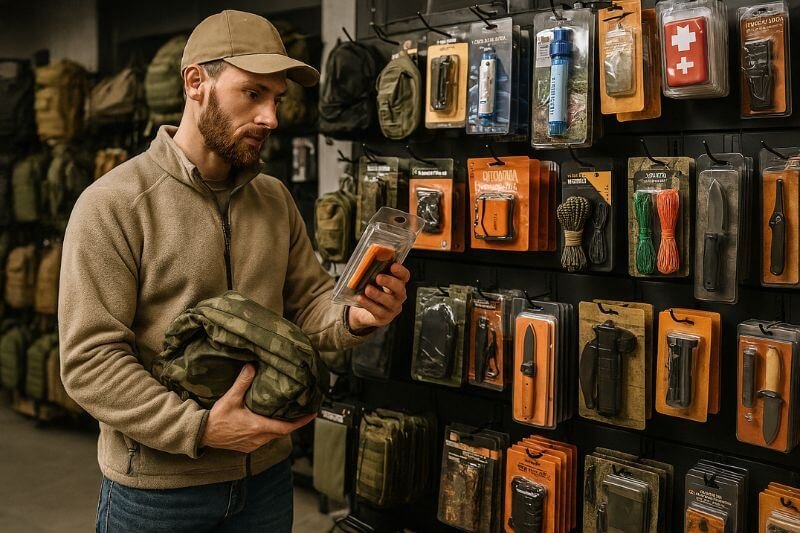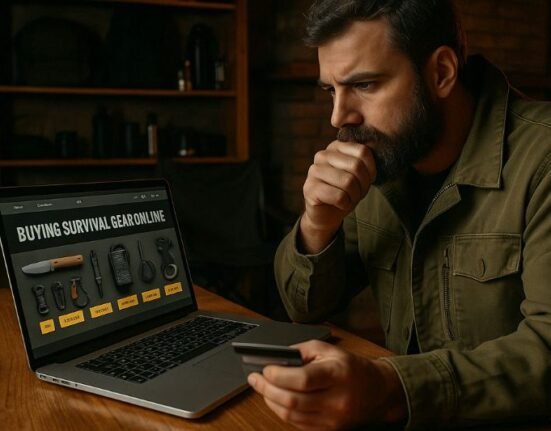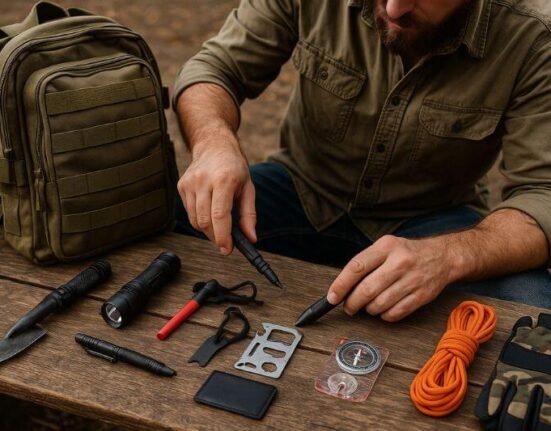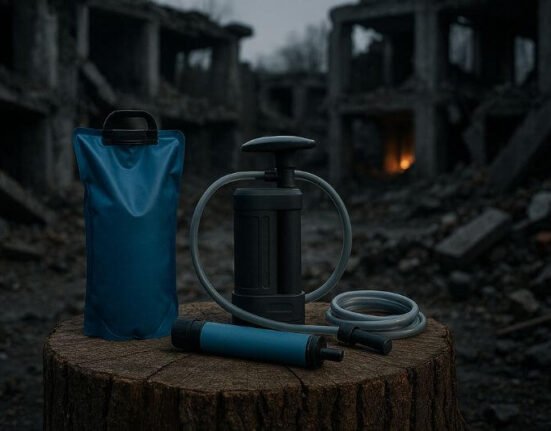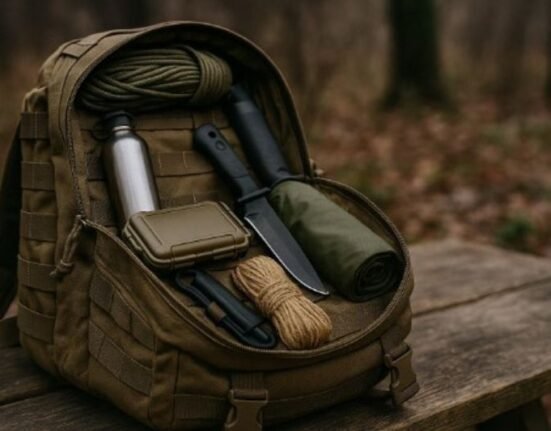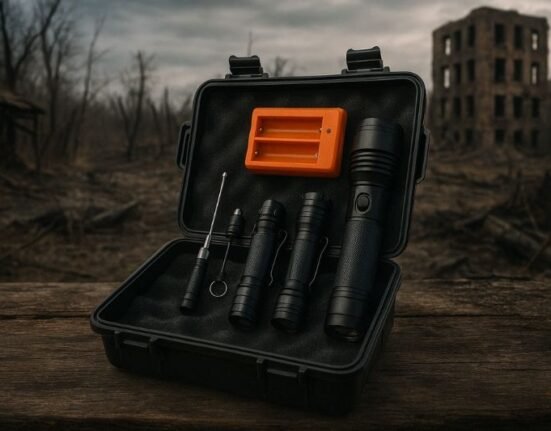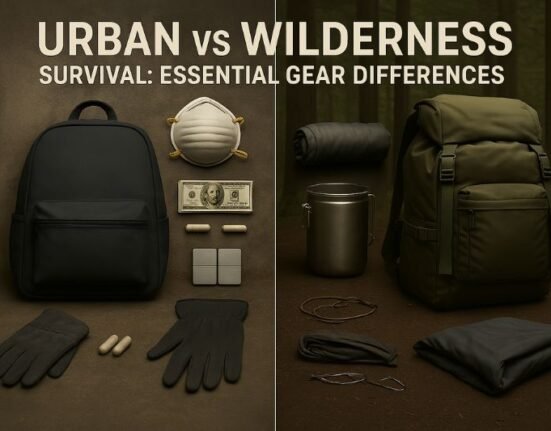In survival, gear is more than just equipment—it’s your lifeline. But not all survival tools are created equal. In fact, a growing portion of what’s sold online under the “prepper” label is poorly made, overhyped, or downright dangerous.
Buying low quality survival gear doesn’t just waste money—it can cost you time, energy, and even your safety when you need performance the most. And with the rise of mass-produced, tactical-looking tools flooding online marketplaces, it’s becoming harder to separate true reliability from flashy junk.
This guide is here to help you identify the warning signs of unreliable gear before it fails you in the field. Whether you’re shopping for your first bug-out bag or upgrading your existing loadout, you’ll learn:
- How to spot red flags in design, construction, and marketing
- What signs experienced preppers use to evaluate gear before buying
- How to test tools yourself—even before a crisis hits
Because in a real emergency, it’s not just about having gear.
It’s about having gear that works.
Why Low Quality Gear Is a Hidden Threat in Survival
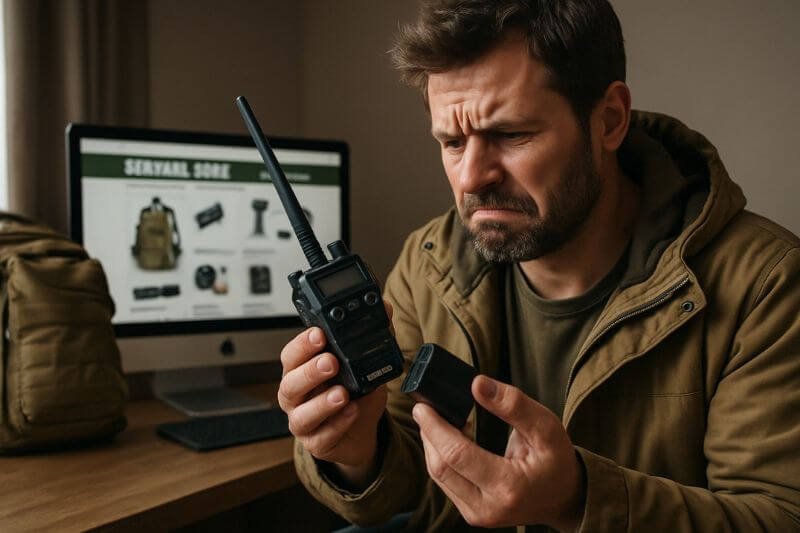
The Illusion of “Affordable Prepping”
Many first-time preppers fall into the trap of “budget prepping.” The logic seems sound: get the most items for the least money. But cheap gear often comes with hidden costs.
Low-priced gear is typically:
- Mass-produced with poor quality control
- Made from inferior materials that fail under stress
- Designed for appearance, not functionality
- Lacking warranties, field-testing, or repair options
It might work in your backyard—but what about in a flooded street, freezing forest, or riot zone?
In survival, the true cost of gear is revealed when things go wrong.
Why Failure in the Field Is Deadlier Than No Gear at All
Carrying bad gear is worse than carrying nothing. Here’s why:
- It creates false confidence, leading you to take risks
- It wastes space and weight in your pack
- It distracts you from better options
- It can fail under stress, wasting critical seconds
Imagine your fire starter snaps, your flashlight flickers out, or your filter leaks during a bug-out. These aren’t minor inconveniences—they’re threats to your survival.
Reliable gear buys time. Faulty gear takes it away.
How Marketplaces Flooded the Prepper Space with Junk
The explosion of e-commerce platforms like Amazon, Wish, and AliExpress brought survival gear to the masses—but also opened the floodgates for poorly made, misrepresented tools.
What changed?
- Sellers began targeting fear-based buyers with “tactical” branding
- Mass-produced gear was rebranded and resold under hundreds of names
- Fake reviews and “military-grade” claims became common
- Quality control took a back seat to volume and appearance
Some items look great in photos but shatter, tear, or rust after a single use.
Today, your job as a prepper isn’t just to buy gear—it’s to become a filter for the filters.
Warning Signs of Low Quality Survival Gear (Across All Categories)
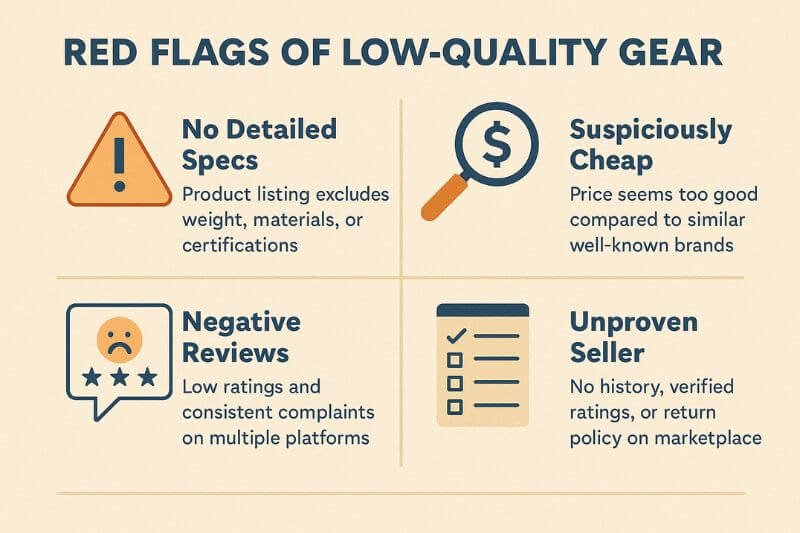
In survival, gear failure isn’t an inconvenience—it’s a liability. One broken buckle, one dull blade, or one unreliable fire starter can derail an entire plan, especially when you’re already dealing with stress, fatigue, or extreme weather.
Identifying low quality survival gear means learning to spot the early indicators of failure, before you’re forced to rely on something that won’t deliver. Here are the five most common categories of red flags to look for across all survival equipment.
Visual Red Flags: When Gear Looks Wrong Before It Fails
Sometimes, bad gear looks bad before you even use it—and that’s a good thing. It gives you a chance to reject it before it ends up in your bag.
Common visual red flags include:
- Shiny, brittle plastics that flex under pressure or feel hollow
- Uneven seams or stitching, especially around stress points like handles or shoulder straps
- Cheap paint jobs or fake coatings that peel, flake, or chip easily
- Misaligned parts, like blades that don’t sit flush or lids that don’t close cleanly
- Overly complex designs with buttons, compartments, or connectors that feel fragile
Example: Some budget fire starters come with painted coatings that look rugged but prevent actual spark production until they’re scraped off—something most first-time users discover too late.
If it looks cheap or hastily assembled, it probably wasn’t built to survive hard use.
Mechanical & Functional Failures: Gear That Doesn’t Do Its Job
Some tools pass the eye test—but fall apart the moment you put them to work. These flaws are often subtle, but deadly.
Functional signs of unreliable gear:
- Loose hinges or weak locks in folding knives and multitools
- Inconsistent flame output in lighters, especially in cold or windy conditions
- Flashlights that dim rapidly or flicker when bumped
- Filters that leak or clog easily with no clear way to backflush
- Zippers, snaps, or buckles that feel brittle or misaligned under strain
Real-world scenario: A user buys a “tactical” folding knife with 4.9 stars online. On the first outdoor use, the liner lock slips under pressure—putting the blade halfway back into the hand.
If it breaks in a backyard test, it will fail when it really matters. Field-test everything before it earns a spot in your kit.
Marketing Deception: How Buzzwords and Fake Reviews Fool Buyers
Online marketplaces are filled with survival gear that sounds impressive—but hides behind deceptive language and review manipulation.
Red flags to watch for in listings and packaging:
- Claims like “military grade” or “used by special forces” with no verification
- Fake review inflation, often via bot accounts or incentivized feedback
- No-name brands using identical designs with different logos (drop-shipped clones)
- Overuse of buzzwords like “tactical,” “elite,” “professional” without test data
- Stock photos only, with no user images or real-world use evidence
Case study: During the pandemic, dozens of “military-grade” masks and filters flooded Amazon, many with glowing reviews—yet failed basic lab testing. Some were made from repurposed costume materials.
In survival, trust must be earned. Don’t let packaging do the talking—demand performance, specs, and proof.
Material Failures: Cheap Builds That Can’t Handle Pressure
Even well-designed gear will fail if the materials used are second-rate. And unfortunately, this is one of the most common issues with mass-produced survival tools.
Material-based red flags include:
- Zinc alloys or pot metal in tools that require strength (blades, handles, carabiners)
- Plastic buckles on backpacks or belts that snap at freezing temperatures
- Non-treated fabrics that tear, fray, or even catch fire
- Thin paracord labeled as “550” but incapable of holding 100 lbs
- Tents and tarps that leak, shrink, or degrade after one exposure to sun or rain
Example: Some survival blankets marketed as “thermal” tear like tissue paper and melt when exposed to open flame—useless in cold or wet conditions.
Materials matter. A weak link in your setup can compromise the entire chain of survival.
Overdesign and Gimmicks: When Tools Try to Do Too Much
“More” isn’t always better. One of the most dangerous traps in the survival gear world is the Swiss Army Syndrome—gear that promises 10 functions and performs none of them well.
Typical offenders:
- Multitools with 15+ functions but no single sturdy blade or usable pliers
- EDC gadgets that combine flashlight + fire starter + charger + glass breaker—but fail at all of them
- “Credit card” survival tools that are impossible to grip or use under stress
- Backpacks with so many zippers and MOLLE straps they become fragile and unwieldy
Test insight: If a tool requires two hands, clear lighting, and a calm environment to operate, it’s probably not ready for a real-world emergency.
In survival, simplicity is strength. Redundancy is safety. Gimmicks are distractions.
How to Vet Survival Gear Before You Click “Buy”
Spotting low-quality gear is one thing. Knowing what to do instead is the real prepper skill.
In a world flooded with clones, gimmicks, and factory rebrands, it’s not enough to scroll through stars and reviews. Real preppers go deeper—testing, researching, and validating every piece of kit before it earns a place in their loadout.
Here’s how you can vet survival gear like someone who’s depending on it for real.
Use Field-Tested Forums, Not Just Marketplace Reviews
Amazon, Walmart, and AliExpress reviews are often misleading. Inflated ratings, bot feedback, and sponsored comments can all distort reality.
Instead, use field-test forums and prepper communities like:
- Reddit’s r/preppers or r/bushcraft
- Bushcraft USA forums
- YouTube channels that test gear in bad conditions
- Specialist blogs with side-by-side comparisons
Real users test gear:
- In mud, snow, and rain
- With gloves, while injured, under pressure
- With realistic bug-out weights or long-term scenarios
If a piece of gear hasn’t been through a storm, blackout, or solo hike, its five-star rating means nothing.
Compare Specs, Not Just Photos
Good gear has specs. Bad gear has hype.
When evaluating a product, go straight to the numbers:
- Knife steel type (e.g., 1095 vs. mystery “surgical steel”)
- Lumens and battery life for flashlights
- Tent hydrostatic ratings (1500mm is weak, 3000mm+ is solid)
- Load-bearing limits of carabiners, webbing, buckles
- Paracord true tensile strength (don’t trust the label—verify reviews)
Example: Some “550 paracord” on marketplaces holds less than 100 lbs in real-world tests.
If the listing doesn’t include materials, capacities, or field-use metrics—walk away.
Perform Realistic Home Testing Before Trusting
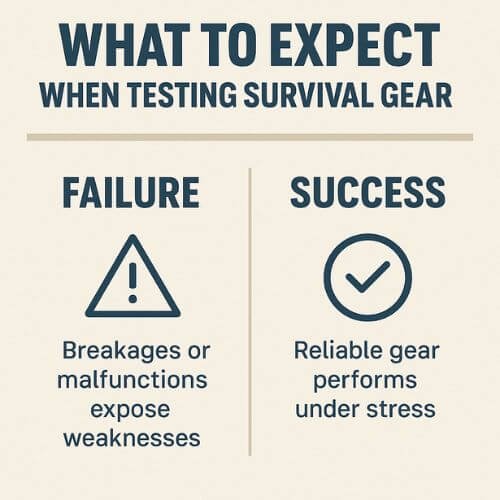
Never add untested gear to your bug-out bag or long-term setup.
Create a basic home test environment:
- Test lighters outdoors in wind and cold
- Strike ferro rods while wearing gloves
- Filter dirty water and see if taste, color, or flow is acceptable
- Use knives to split kindling, cut rope, or process food
- Time headlamps and flashlights under real use (not just on a full charge)
Don’t wait for an emergency to find out your “survival tool” is actually decorative junk.
Build a Personal Test Kit for Evaluation
Consider maintaining a dedicated gear evaluation bag—a small kit that helps you test items before they join your real BOB or INCH bag.
Include:
- A known-reliable ferro rod, knife, lighter
- A 550 paracord sample, duct tape, steel file
- Fuel, water, tinder, and basic load weights
- Multimeters or test strips for electrical and water gear
This lets you compare unfamiliar gear against a trusted baseline.
Your real-world kit should be elite. Everything else is “on probation.”
Ask These 5 Questions Before You Buy Any Survival Tool
- Can I rely on this tool in the dark, while stressed, or injured?
- Has this gear been used in real crises—or just marketing videos?
- Can it be operated with gloves, wet hands, or one hand only?
- Do I already have a redundant or better-quality version of this item?
- Would I trust my life—or someone else’s—with this tool right now?
If you hesitate on any of those questions, don’t buy it—or don’t deploy it yet.
Frequently Asked Questions (FAQ)
🔧 Can Cheap Survival Gear Be Upgraded or Reinforced to Make it Usable?
Yes—sometimes. But it really depends on the gear itself and its intended use.
✅ Some gear can be field-ready with minor modifications:
- Reinforcing tarp grommets or poncho edges with durable tape
- Replacing weak plastic buckles with sturdy metal carabiners or clips
- Waterproofing fabric seams using sealant spray or seam tape
- Adding extra sheaths or protective coverings to cheaply-made knives and tools
- Carrying backup fuel or extra cordage to reinforce fragile components
❌ However, some gear is simply beyond repair:
- Water filters with non-standard threads or sealed/glued parts
- Tools made from low-quality metal prone to snapping under light stress
- Flashlights with integrated, sealed batteries that quickly die
- Cheap lighters that fail under cold, windy, or wet conditions
🧠 Rule of thumb:
If the gear has a structural defect, DIY improvements likely won’t help. If the issue is about comfort, redundancy, or weather resistance, it might be salvageable.
🛡️ Are Name-Brand Survival Tools Always Better Than Unbranded or Generic Ones?
Not always—but they’re generally more predictable.
✅ Reputable brands often offer:
- Standardized materials and consistent quality
- Reliable quality control across multiple batches
- Proven track record with extensive community feedback
- Better customer support and warranty coverage
⚠️ But keep in mind:
- Some brands outsource to factories also used by cheaper products
- You could pay 30–60% more just for branding
- Certain “brands” are simply dropshipping websites with no quality control
🧠 Best practice:
Always check specifications, independent field tests, and reviews before trusting the brand name. A generic tool with excellent steel and field-proven reliability beats a branded gimmick relying on paid hype.
📉 How Do Fake Reviews Distort the Reputation of Survival Gear?
Fake reviews are one of the biggest threats facing preppers trying to make informed gear choices, creating misleading confidence in subpar products.
⚠️ Fake reviews can:
- Promote dangerously weak gear into bestseller rankings
- Overshadow real feedback from experienced users
- Hide critical flaws like battery swelling, rust issues, or plastic fatigue
- Pressure buyers into decisions based on false majority opinions
🚩 Red flags indicating fake reviews:
- Numerous identical, vague reviews (“Great product! Works perfectly!”)
- Multiple 5-star ratings appearing immediately after product launch
- Reviews using generic, stock, or AI-generated images
- Unverified purchases leaving glowing yet unspecific praise
🧠 Pro tip:
Use tools like Fakespot or ReviewMeta, or search for unbiased user opinions by typing the product name + “Reddit.”
🧨 What’s the Biggest Mistake First-Time Preppers Make When Buying Gear Online?
Trying to assemble an entire survival setup instantly by purchasing cheap gear just to “tick all the boxes.”
⚠️ This common error results in:
- A bug-out bag filled with unproven or unreliable tools
- Over-reliance on flashy, yet fragile items
- False confidence shattered at the first real test
- Money wasted on duplicates, backups, and last-minute replacements
✅ The solution is building your kit slowly, deliberately, and thoroughly tested:
- Prioritize essential gear: water, shelter, fire, and medical supplies
- Test your gear at home, outdoors, and under real stress conditions
- Focus on modular, reliable gear instead of sheer quantity
- Gradually upgrade items as budget allows, replacing the weakest links first
🧠 Remember:
Your gear doesn’t need to look Instagram-worthy—it needs to function reliably in darkness, cold, and exhaustion.









